 Most viewed - Private Collection of Richard Hanley - 25 Infantry Battalion
|
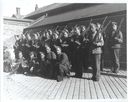
IEMA-P-096-0621441 viewsIn September 1939, the strength of the regular army was approximately 6,000. Together with the reserves, particularly the Volunteer Force, the total did not exceed 20,000. On the 10 May 1940, when the German offensive in Western Europe began, the total in permanent service did not exceed 13,355. However, by 31 March 1941 the total reached a figure of 41,463. This rapid increase in personnel put enormous pressure on the regular army cadres and the volunteer force and it is too their credit that a well trained, if ill-equipped, force was quickly established to depend against invasion.
|
|
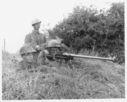
IEMA-P-067-0221249 viewsThe critical shortage of equipment was exemplified by the lack of anti-armour weapons. In March 1940, the army possessed one 57 mm anti-tank gun and fourty-one Boyes .55inch anti-tank rifles. Only a further 6 guns and 100 rifles were delievered by the end of the Emergency.
|
|
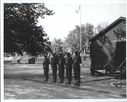
IEMA-P-096-0301211 viewsCamp Guard awaiting the arrival of the Orderly Officer – 25th Battalion line, Bawnjames Military Camp, New Ross, Co. Wexford – 16 August 1942.
|
|
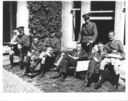
IEMA-P-067-0251209 viewsOfficers of the 25th Battalion relaxing after lunch outside their headquaters, Bawnjames House, New Ross – 07 June 1942. The emergency brought together not alone those who had fought in 1916 and the War of Independence but also those who who had fought on opposing sides during the Civil War.
|
|
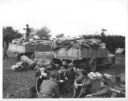
IEMA-P-067-0311201 viewsHurry up and wait! Packing up bivouacs and blankets after an overnight Camp, Flood Hall, Kilkenny – 24 August 1944.
|
|
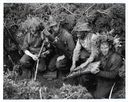
IEMA-P-096-0431191 viewsA rare shot of a Mortar Crew. Mortars were in very short supply. Total Stocks in March 1940 were forty eight (48) Brandt 81 mm and one (1) Brandt 60mm. A further fifty (50) 3-Inch Mortars were supplied by Britain in late 1943. This photograph was taken during a live firing practice in the Comeragh Mountains – 09 September 1944.
|
|
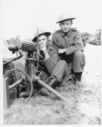
IEMA-P-067-0121145 viewsA Vickers Machine Gun Crew. The Vickers and the lighter Lewis Gun, with the Lee Enfield Mark III rifle, were the main weapons of the infantry battalions.
|
|
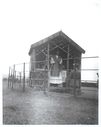
IEMA-P-096-0051121 viewsAn improvised alter at Castle Annagh Camp outside New Ross – 05 July 1942. The Army fought a long battle with the Heirarchy to have chaplains appointed to units so that they could accompany the troops on exercise. The Bishops were not intailly in favour of priests travelling outside their dioceses.
|
|
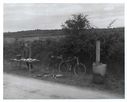
IEMA-P-096-0071106 viewsThe quartermaster waits by the roadside to provide welcoms nourishment to the marching troops – near Dunmore East, Co. Wexford – 16 July 1942.
|
|
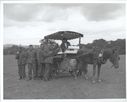
IEMA-P-096-0061097 viewsIce Cream comes to Camp Mount Pleasant, Co. Waterford – 18 July 1942.
|
|
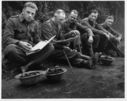
IEMA-P-067-0101083 viewsCatching up with the news.
|
|
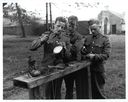
IEMA-P-096-0031018 viewsIt was difficult to maintain boots for inspection. The periodical shortages of polish and the tough treatment caused by long marches and turf cutting meant many tough moments on the parade grounds.
|
|

IEMA-P-062-370965 viewsCompany officers holding an ‘O’ (orders) group prior to an attack on the ‘Enemy’.
|
|

IEMA-P-062-375965 viewsTaking a well earned rest from turf cutting – Killamuck Camp, Abbeyleix, Co. Carlow. – 23 July 1943.
|
|

IEMA-P-062-321910 viewsQuartermaster Brett, 25th Battalion, checking his ‘inventory’ of turkeys while based at Ballinamona Camp near Tramore, Co. Waterford – 04 September 1944.
|
|

IEMA-P-062-357887 viewsNot all fun and games, hard work was necessary.
|
|
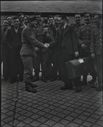
IEMA-P-062-309868 viewsCaption – Back to ‘Civvy Street’ 1946
|
|

IEMA-P-062-369846 views‘Step together’ week, New Ross – 02 May 1943. Many large towns organised special weeks involving parades, concerts and sports events in which military and civilians participated.
|
|

IEMA-P-062-223820 viewsFollowing the return of a group of selected officers who had undergone British Army commando courses, a greater emphasis was placed on fieldcraft training and fitness – Slieve Caoilte, Co. Wexford 11 June 1943.
|
|

IEMA-P-062-339819 viewsTroops taking a break on the roadside outside Cahir, while advancing southwards to the Blackwater – 21 August 1942.
|
|

IEMA-P-062-006799 viewsSkinheads are not a new phenomenon! NCO’s and men of the 25th Battalion showing off their haircuts while on brigade manoeuvres, Castle Annagh Camp, New Ross – 06 July 1942.
|
|

IEMA-P-062-323781 views‘The Nation is Profoundly Grateful’
|
|

IEMA-P-062-129749 viewsA room orderly has a quiet moment alone. 25th Battalion lines, Bawnjames, Co. Wexford – 13 July 1942.
|
|

IEMA-P-062-128725 viewsHundred of billets were erected throughout the country to cater for the repid increase in personnel.
|
|

IEMA-P-062-043722 viewsThe Blackwater manoeuvres are synonymous with the Emergency. Involving over 20,000 troops, the lasted from 17 August 1942 to 27 September 1942 and pitted the 2nd Spearead division under Maj Gen Hugo McNeill against Maj Gen M.J Costello’s 1st Division. Here the 3rd Battalion passes the 25th Battalion outside Fethard, Co. Tipperary, to take over as advance guard of the Brigade as they proceed southwards with the Spearhead Division – 20 August 1942.
|
|

IEMA-P-062-036712 views‘A group of warriors’ having a rest, following a tea break, outside Silversprings House, Pilltown, Co, Kilkenny, while on a training exercise prior to the Blackwater Manoeuvres - July 1942. The outdoor life, coupled with the fine weather in the summer of 1942, is reflected in the weather beaten faces.
|
|

IEMA-P-062-117710 viewsBrigade Camp, Youghal – 17 September 1942 – John Harbourne, canteen Manager, serving troops in the open air canteen.
|
|

IEMA-P-062-054700 viewsTroops on reconnaissance operations passing through Mitchelstown, Co. Cork – 28 August 1942.
|
|

IEMA-P-062-048679 viewsA Battalion Bivouac area, among the ruins of the former British military barracks in Cahir, Co. Tipperary – 21 August 1942.
|
|

IEMA-P-062-018676 viewsTea arriving at the ‘Front Line’ during manoeuvres between Waterford City and Tramore – 28 August 1944.
|
|

IEMA-P-062-045674 viewsTraining for the 56,000 who saw permanent service during the Emergency was arduous. Blistered feet were a common occurance, particulary in the early days.
|
|

IEMA-P-062-037673 viewsPay parade – Lullymore Camp – 04 August 1942. One can only guess at what the Company Sergeant has said to the soldier waiting in line!!!
|
|

IEMA-P-062-237669 viewsReady for inspection.
|
|

IEMA-P-062-196662 viewsHaving a wash at the end of the day.
|
|

IEMA-P-062-024659 viewsPrivate Richard Hanley (on the right) finally allows someone else to use his camera – 20 July 1942.
|
|

IEMA-P-062-065653 viewsVictory for the 2nd Division! Troops of the 25th Battalion crossing the Blackwater – 3 September 1942.
|
|

IEMA-P-062-060637 viewsTea break during manoeuvres. The armbands on the left arms are to facilate umpires in identifying the opposing forces.
|
|

IEMA-P-062-051624 viewsA company commander holding ‘Company Orders’. Company commanders were empowered were empowered to deal with minor offences such as absenteeism.
|
|

IEMA-P-062-022609 viewsA welcome break during manoeuvres.
|
|

IEMA-P-062-290606 viewsFun and games.
|
|

IEMA-P-062-139567 viewsThe pride of the unit – do you know who they are?
|
|
|
|
|
